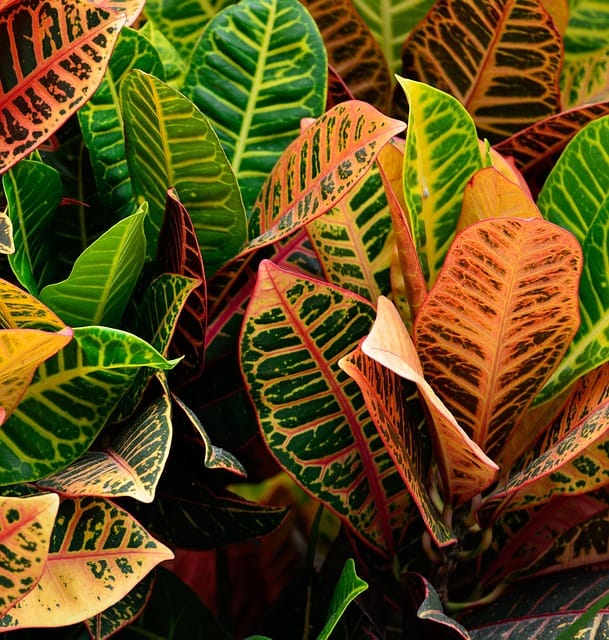How to grow Croton Plants
Introducing croton plants as indoor plants can add a touch of beauty and vibrancy to your home or office

In this article:
Introduction
Introducing croton plants as indoor plants can add a touch of beauty and vibrancy to your home or office. These tropical plants are known for their colorful and eye-catching foliage, making them popular among plant enthusiasts. In this article, we will provide a comprehensive guide on how to successfully grow croton plants indoors.
Overview of Croton Plant
Croton plants (Codiaeum variegatum) are native to tropical regions and require a warm and humid environment to thrive. They are characterized by their glossy, leathery leaves that come in a variety of colors and patterns, ranging from vibrant greens to shades of yellow, red, and orange. Croton plants can reach up to 6 feet in height, making them excellent choices for adding height and drama to indoor spaces.
Choosing a Croton Plant Variety
When selecting a croton plant for indoor cultivation, it is essential to consider the available space and light conditions. There are numerous croton varieties to choose from, each with its distinct leaf shape, color, and growth habit. Some popular varieties include 'Petra,' 'Mammy,' 'Norma,' and 'Gold Dust.' Research and select a variety that suits your aesthetic preferences and growing environment.
Light Requirements
Croton plants are light-loving plants that require bright, indirect light to thrive. Place them near a window with filtered sunlight or use artificial grow lights if natural light is limited. Avoid exposing croton plants to direct sunlight as it can scorch their sensitive foliage. Regularly rotate the plant to ensure even sunlight exposure and prevent one-sided growth.
Temperature and Humidity
Croton plants are tropical plants that thrive in warm temperatures between 60°F to 85°F (16°C to 29°C). Avoid placing them in cold or drafty areas. High humidity levels are also crucial for croton plants' health. Consider placing a humidifier nearby or regularly mist the plant with water to create a humid microclimate around it.
Watering Needs
Proper watering is crucial for the success of croton plants. Keep the soil evenly moist but not overly saturated. Allow the top inch of the soil to dry out before watering again. Avoid waterlogging or allowing the plant to sit in standing water, as this can cause root rot. Adjust the watering frequency based on the environmental conditions and the needs of the plant.
Soil and Fertilizer
Use well-draining potting soil with good water retention properties. A mix of peat moss, perlite, and vermiculite can provide the ideal growing medium for croton plants. Fertilize the plant every 2-4 weeks during the growing season (spring and summer) using a balanced, water-soluble fertilizer. Reduce fertilization during the dormant period (fall and winter) to promote healthy growth.
Propagation Methods
Croton plants can be propagated through stem cuttings. Select a healthy stem with several leaves and make a clean cut just below a node. Remove the bottom leaves, dip the cut end in rooting hormone, and plant it in a container filled with a well-draining soil mix. Place the container in a warm and humid environment, ensuring the soil remains moist until roots develop.
Pruning and Maintenance
Regular pruning helps maintain the shape and size of your croton plant. Prune any leggy or damaged branches to encourage bushier growth. Pinch back the growing tips to promote branching. Wipe the leaves occasionally with a damp cloth to remove dust and keep them looking shiny. Inspect the plant regularly for signs of pests or diseases.
Common Pests and Diseases
Croton plants are susceptible to pests such as mealybugs, spider mites, and scale insects. Thoroughly inspect the plant regularly to catch any infestations early. Treat pest problems using natural remedies like neem oil or insecticidal soap. Additionally, be cautious of common diseases like leaf spot and root rot, which can be prevented by avoiding overwatering and improving air circulation around the plant.
Potential Issues and Troubleshooting
If you encounter issues with your croton plant, such as yellowing leaves, leaf drop, or stunted growth, it may be due to improper care or environmental conditions. Review the plant's sunlight, temperature, humidity, watering, and fertilization needs and make necessary adjustments. Providing optimal conditions and addressing any problems promptly will help your plant thrive.
Decorating with Croton Plants
Croton plants' vibrant foliage makes them excellent decorative elements in any indoor space. They can serve as stunning focal points on tabletops, shelves, or plant stands. Consider combining croton plants with other houseplants to create visually appealing arrangements. Their bold colors can add a pop of warmth and personality to any room.
Conclusion
Growing croton plants indoors can be a rewarding experience for plant enthusiasts. By providing the right light, temperature, humidity, and care, you can enjoy the beauty of their colorful foliage and bring life to your living or working space. Remember to choose the right variety, follow proper watering and fertilization routines, and address any issues promptly to ensure the health and vitality of your croton plant.
